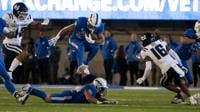Aiden Calvert seems to be on the verge of securing the tailback position for Air Force.
In some years, that would have been the bold headline from fall camp. That it’s not the attention-grabber for the Falcons this August speaks to the quantity of new starters (including quarterback), the fact that Kade Frew is still very much in the mix at tailback and, most importantly, the evolution of the position in the offense.
“Just do what I know best,” Calvert said, a senior, when asked how he might emerge as a key weapon in an offense that has leaned recently on the fullback position. “When I get the chance to run the ball, do what I have to do. If I’m not running the ball, throwing those blocks that I need to so others on the team can get those runs.
“Just keep the other team guessing, with the triple-option that’s the name of the game.”
The tailback had been the focal point of the triple-option early in coach Troy Calhoun’s tenure, but that hasn’t been the case recently.
From 2010 to 2016, tailbacks (or players who primarily played the position) led the team in rushing. The top tailback averaged 1,040 rushing yards during that stretch.
Then there was a two-year gap before Kade Remsberg put up a 1,000-yard season as a tailback in 2019.
Then, everything changed. Brad Roberts emerged in 2020 and opened an era in which the fullbacks have put up the biggest numbers — including Roberts’ national-best 1,728 yards in 2022.
The tailbacks have taken on a secondary role, with the leading tailback averaging 454 yards over the past three years.
Offensive coordinator Mike Thiessen feels this team has the ability at the skill positions to stay away from such extreme patterns and tendencies this season.
“I think we’re pretty talented across the board, to be honest with you,” Thiessen said. “No matter how we want to go attack somebody, whether it’s on the perimeter or up the middle or with the quarterback, I think we’ve got some guys at every one of those spot that we’re not afraid to put the ball in their hands.”
At fullback, the Falcons return Dylan Carson. Largely in a reserve role last year behind leading rusher Emmanuel Michel, Carson ran for 483 yards on 68 carries. The questions surrounding Carson this preseason are not if he’ll be the primary fullback, but how many carries he’ll see as the team would prefer not to revisit the days when Roberts’ workload was so intense that he set a program record for rushing attempts in consecutive years.
At tailback, there are Calvert and Frew — a tandem from two of the best prep programs in the nation.
Calvert, who came from Mater Dei Catholic in California, has seen action in 17 games over the past two seasons, running 27 times for 222 yards (an 8.2 yards-per-carry average) and a touchdown.
“Does have very good top-end speed,” said Calhoun, who moved Calvert to fullback during spring practice but has had him back at tailback throughout fall camp.
Frew is the all-time leading rusher at the Bolles School in Florida. A junior, he has logged just one carry for 3 yards so far at Air Force.
“Doesn’t change too much,” Calvert said of the difference when he or Frew is on the field, as they bring similar speed and a willingness to run with power between the tackles. “It’s a good synergy.”
Air Force opens the season at home on Aug. 31 against Merrimack, an FCS opponent.
If Calvert — or Frew, or perhaps someone else down the depth chart — can unlock pieces of the offense that have been left untapped in recent years, don’t be surprised if it is the tailback position that is once again grabbing the headlines.



